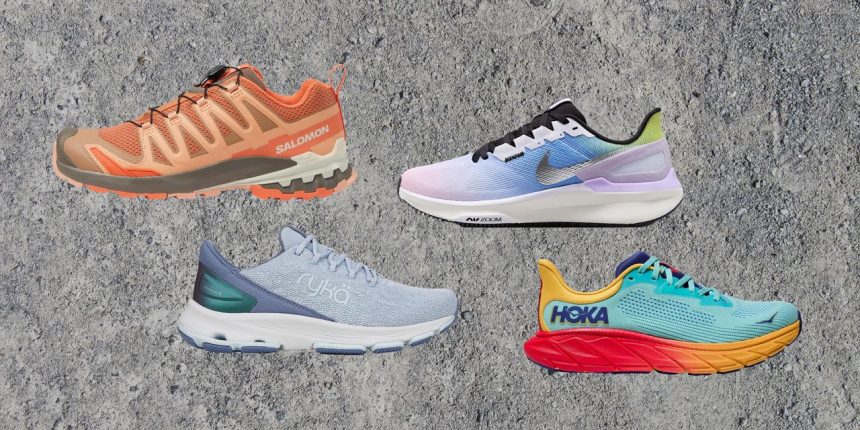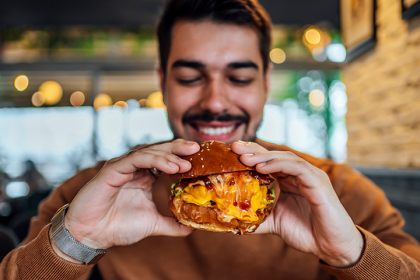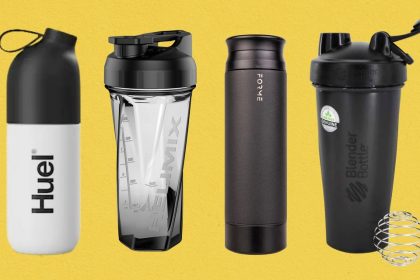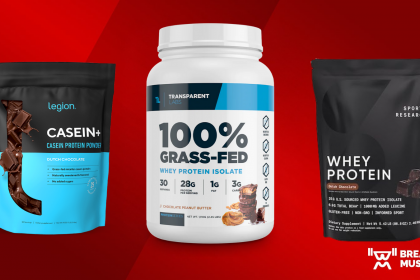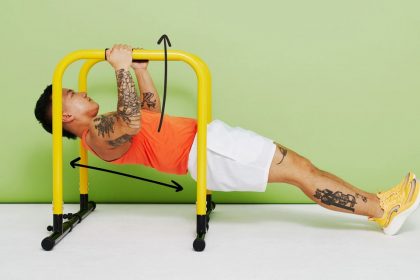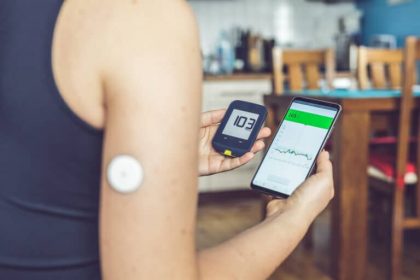Having flat feet doesn’t mean you’re destined for a life of discomfort. With the right shoes, you can reliably walk all day long, run all of your errands, or do anything you’d like for hours on end without feeling that tell-tale pain in your arches, heels, or elsewhere.
The key to finding the best walking shoes for flat feet is to look for pairs with good (but not too much) arch support, a stable design, and some flexibility—enough that it bends, but doesn’t fold in half. Below, experts in podiatry and physical therapy share their best tips for shopping for flat foot-friendly walking shoes, plus options that are just begging to be worn on your daily walks.
Our top picks
- Best Overall: Hoka Arahi 7, $145
- Runner-Up: Kuru Atom, $159
- Best Budget Pick: Ryka Devotion X, $110
- Best for Maximum Cushioning: Hoka Gaviota 5, $175
- Best for Plantar Fasciitis: Brooks Adrenaline GTS 24, $140
- Best for Wide Feet: New Balance 1540 V4, $180
- Best for Standing All Day: Asics GT-1000 13, $110
- Best for Walking Long Distances: Keen WK500, $135
You’ll probably need to try on a few pairs to determine what feels best for your feet. But you can get a leg (or foot) up on your search by starting with this list. Our picks include expert-recommended brands like Hoka and Chaco, as well as SELF editor-tested and -approved options.
Best Overall: Hoka Arahi 7
Both Dr. Gremillion and Dr. Piekarska recommend Hoka sneakers—the latter describes them as “stable yet comfortable”—and many of the brand’s shoes have won a seal of acceptance from the American Podiatric Medical Association (APMA) for their foot-friendly designs.
The Arahi 7 is a good option for flat feet because it’s designed to prevent overpronation (a.k.a when your feet and ankles roll inward as you walk, a common problem for people with low arches), which can lead to heel pain, according to Dr. Piekarska. We also like this style for runners with flat feet, especially if your feet are on the narrow side.
“I love wearing my Arahi 7s when I’m in a state of mind to get stuff done. They’re certainly comfortable and cushioned, but with a stack that’s a little less voluminous and more responsive than other Hoka models. I feel a more grounded and ready roll,” says one SELF tester. “Not ready to roll, though, are my arches, which are held firmly in place in this stability shoe.”
Sizes: US 5 to 12 | Widths: Medium and wide | Heel-to-toe drop: 5 millimeters | Weight: 8.10 ounces
Runner-Up: Kuru Atom
Kuru’s best-selling Atom sneaker features a deep heel cup that hugs the back of your foot and a curved, contoured arch for extra support where you need it most. Our tester was impressed by how firm (yet comfortable) the arch was, noting that it felt great on long walks on hard pavement, with one caveat: “It feels like its placement is a little too far back in the shoe—the upper end of my arch didn’t get quite the same amount of support as the rest of it.”
For all its sturdiness, the Atom kept our tester’s feet cool and fresh after long periods of wear, thanks to its breathable mesh upper. It’s somewhat lacking in padding, especially in the forefoot, which is why it falls short of our top pick. But if structure takes priority over cushioning for you, the Atom could very well be your personal best overall.
Sizes: US 5 to 12 | Widths: Medium and wide | Heel-to-toe drop: 8 millimeters | Weight: 10.60 ounces
Best Budget Pick: Ryka Devotion X
Ryka’s best-selling (and AMPA-approved) Devotion X shows you don’t have to shell out for the fanciest pair of walking shoes on the market to get good arch support. Its insole has a built-in arch, and its midsole provides additional structure around the middle of the foot. As a fitness-walking-specific shoe, it also doesn’t skimp on comfort: There’s extra padding in the forefoot and heel to help absorb the impact of your steps, and the mesh upper helps keep your feet cool on warmer days.
Sizes: US 6 to 12 | Widths: Medium and wide | Heel-to-toe drop: 10 millimeters | Weight: 10.75 ounces
Best for Maximum Cushioning: Hoka Gaviota 5
Another highly supportive and APMA-approved option from Hoka is the Gaviota 5. With more cushioning than the Arahi, it’s comparable to the 2023 SELF Sneaker Award–winning Hoka Bondi—but with a focus on stability over plushness, for folks with flat feet who still love a highly cushioned shoe. The Gaviota’s H-Frame design gently keeps your foot in the correct alignment—a win for overpronators.
This latest version of the Gaviota improves on previous models with a slightly wider fit, increased airflow through the upper, and an even softer feel. Between its plush padding and easy breathability, the Gaviota will keep a spring in your step, even on long days spent running all over town.
“As someone who overpronates, I can confirm that the Gaviotas are incredibly stabilizing while also providing that walking-on-a-cloud feel I look for in a Hoka,” one SELF tester says. “I also like how breathable they are and the roominess of the toe box—no foot sweat or toe claustrophobia over here.”
Sizes: US 5 to 12 | Widths: Medium and wide | Heel-to-toe drop: 6 millimeters | Weight: 9.10 ounces
Best for Plantar Fasciitis: Brooks Adrenaline GTS 24
Nicholas Japs, DPT, a physical therapist at St. Vincent’s Medical Center in Bridgeport, Connecticut, previously recommended the Brooks Adrenaline GTS for people who deal with plantar fasciitis. It has a larger heel-to-toe drop than other shoes on our list, which helps take more pressure off your heel and will (hopefully) relieve some of the pain that comes with the condition.
Beyond that, it’s a very well-cushioned, supportive sneaker, with two pieces of firm foam on either side to help keep your foot aligned while you’re on the move. One SELF staffer considers the Adrenaline her “workhorse” sneaker, explaining that she wears her pair for everything but speed training: “I overpronate while I run, and these give me the support I needed to build up my mileage pain-free.”
Sizes: US 5 to 13 | Widths: Narrow, medium, wide, and extra wide | Heel-to-toe drop: 12 millimeters | Weight: 8.8 ounces
Best for Wide Feet: New Balance 1540 v4
New Balance
1540 V4 Running Shoe
If you’re ready to embrace the dad shoe trend (which is really just an excuse to wear super comfy walking shoes), New Balance is a great brand to browse. Designed to provide maximum structure, comfort, and motion control (to prevent rolling), the 1540 V4 can help keep flat feet happy—all while meeting your normcore aspirations.
Bonus: It comes in three widths, so if you often struggle to find a shoe with enough room in the toe box, we highly recommend giving this one a try.
Sizes: US 6 to 13 | Widths: Standard, wide, x-wide | Heel-to-toe drop: 4 millimeters | Weight: N/A
Best for Standing All Day: Asics GT-1000 13
A previous iteration of the GT-1000 won a Sneaker Award last year, wowing our tester with how comfy it felt—even for hours at a time. “These are very light, breathable, and springy, and mold to your foot effortlessly. My finicky arches loved them,” they said. The GT-1000 13 is even more structured, thanks to some new stability features in the midsole.
This pair of sneaks is ideal for standing all day: As SELF has previously reported, it’s important for your footwear to provide enough support (usually in the form of sturdy, stiff insoles) if you’re going to be on your feet for long periods of time. Whether you’re headed to a concert or working a long shift, the GT-1000 13 will help prevent foot fatigue and pain.
Sizes: US 5 to 12 | Widths: Medium | Heel-to-toe drop: 8 millimeters | Weight: 8.30 ounces
Best for Walking Long Distances: Keen WK500
Keen’s WK500s have a curved sole, which is more common in running shoes and gives these walking shoes a distinctive, rocker-like shape. The effect? Constant movement. One SELF staffer, who logged serious steps wearing the previous edition (the WK400s) over several years, especially appreciated the curved sole while she was rushing to tackle multiple errands around her neighborhood.
“I’m a pretty fast walker as it is, but I feel like I have tiny jetpacks strapped to my feet when I wear these shoes,” she says. “Once you start moving, they really help you build up and maintain your momentum.” The updated WK500 weighs nearly two ounces less, which adds to that light-on-your-feet feeling.
Sizes: 5 to 12 | Widths: Medium | Heel-to-toe drop: 11 millimeters | Weight: 8.96 ounces
Best for Walking and Running: Nike Structure 25
Alicia Canzanese, DPM, ATC, a board-certified podiatrist, athletic trainer, and former collegiate track athlete, previously recommended the Nike Structure to SELF, noting that it’s a lightweight and supportive stability shoe (meaning it’s designed with support through the arch to prevent pronation). That’s a rare combo to come by, and it’s the main reason why this sneaker is great for walking and running—it’ll feel sturdy while you stroll, but won’t weigh you down when you pick up the pace.
And, despite its relatively low weight, it still packs a ton of foam throughout the sole, so you’re sure to stay comfy.
Sizes: US 5 to 12 | Widths: Regular and wide | Heel-to-toe drop: 10 millimeters | Weight: 8.50 ounces
Best Sandal: Chaco Z/1 Classic
Ask any podiatrist and they’ll tell you that your sandals absolutely must have decent arch support—and that you should save your flip-flops and slides for only the shortest walks. It’s no wonder, then, that Chaco’s strappy Z/1 Classic has been recommended to us over and over again. Its thick, molded footbed (which you can find in most Chaco models) is approved by the APMA, but it isn’t just a favorite among professionals.
Our senior commerce editor, who has very flat, narrow feet and is a sworn sandal-hater, considers her Chacos some of the most comfortable summer footwear she owns: “I have very low arches that are prone to collapsing, but they feel nicely supported in the Z/1,” she wrote in her review. “They don’t feel foamy or squishy, but that’s not to say they’re rock-hard, either—the Z/1’s insole has some give to help absorb the impact of my footsteps, and it’s flexible enough to bend with my foot while I walk.”
Sizes: US 5 to 12 | Widths: Medium | Heel-to-toe drop: 6.35 millimeters | Weight: 11 ounces
Best for Trails: Salomon XA Pro 3D V9 Hiking Shoes
Salomon
XA Pro 3D V9 Hiking Shoes
Dr. Gremillion points to Salomon as a solid brand for outdoor excursions, and this trail runner is a particularly good choice for flat feet. It’s designed with a sturdy structure that helps keep the foot stable, even on rugged ground. With a moderate amount of cushion, it can help you feel comfy on the move while staying connected to the terrain underfoot.
Sizes: US 5 to 11 | Widths: medium | Heel-to-toe drop: 11 millimeters | Weight: 10.60 ounces
Best Clog: Dansko XP 2.0
A reliable pair of clogs is perfect for weekend hangs, errands runs, or long shifts on your feet. Danskos in particular are great for people with flat feet (or anyone with a passion for “ugly” shoes), thanks to their APMA-accepted design. The footbed is sturdy, lifted in the arch, and padded with memory foam—it’s also removable, in case you use custom orthotics or OTC inserts. The whole shoe has a structured interior and a rocker bottom, which work together to keep you stable when you’re on the go.
Sizes: EU 35 to 43 | Widths: Medium and wide | Heel-to-toe drop: 25.40 millimeters | Weight: 13 ounces
Best for the Office: Birkenstock Honnef City Sneaker
Birkenstock
Honnef City Sneaker
For flat-footed fans of Birkenstock’s widely beloved slides—like the Arizona sandals and Boston clogs—the Honnef City Sneaker might just be the perfect office shoe. Its iconic removable cork and latex footbed provides foot-hugging support all day long.
“I love wearing these for daytime activities and errands that’ll have me on my feet a lot, but in outfits that I might prefer to not pair with a running-style shoe,” says one SELF tester. “These look great with a sundress, jeans, or athleisure.” Just be sure to size up, so your toes have enough room to spread out.
Sizes: US 5-5.5 to 10-10.5 | Widths: Narrow to medium | Heel-to-toe drop: N/A | Weight: N/A
How to choose the best walking shoes for flat feet
When we talk about the arch of your foot, we mean the area between the ball of your foot and your heel. If you’re not sure what type of arches you have, stand up and check the inner sides of your feet. If they’re flush against the floor, you have low arches, a.k.a. flat feet, Robert Gillanders, PT, DPT, previously told SELF. Knowing your arch type (and taking the factors below into account) will help you find the comfiest, most supportive shoes.
When shopping for shoes, the first thing you should check is the shoe’s arch height, or how much the middle of the insole curves inward and upward. This part of the shoe should match your foot’s shape—with one exception. If you have very low arches or flat feet, you don’t want the inside of your shoe to be entirely flush to the ground, Paulina Piekarska, DPM, a foot and ankle specialist and surgeon at Hartford HealthCare Connecticut Orthopaedic Institute St. Vincent’s Medical Center, tells SELF. But if you try on a shoe and feel pressure against your midfoot, that means the shoe’s arch is likely too high for you, Dr. Piekarska says.
Without any arch support, your foot will flatten and roll inward while you walk, which can cause foot pain, ankle pain, and issues with your tendons, she adds.
Your foot should feel held and supported by the shoe, which will help you feel comfortable longer. It’ll also take some stress off your knees and lower leg muscles, which tend to work harder to help you walk and maintain balance when you have flat feet, Jared Gremillion, DPM, a podiatric surgeon at Holston Medical Group in Bristol, Tennessee, tells SELF. (Wearing supportive shoes can also help prevent plantar fasciitis, a condition characterized by stabbing heel pain—ouch.)
Cushioning can also affect a shoe’s stability for people with flat feet, so be wary of designs that feel too soft or cause your feet to sink.
If you can fold a shoe in half, it’s not supportive enough, Dr. Gremillion says. Your shoes should be rigid, but still flexible enough to bend with your foot when you’re walking—that’ll give you a nice balance of stability and freedom of movement.
A shoe’s heel-to-toe drop is measured in millimeters and refers to how tall the sole under the forefoot is compared to the heel. There’s no universally “correct” drop—but as Rich Willy, PT, PhD, associate professor at the University of Montana and director of the Montana Running Lab, previously told SELF, higher drops may relieve pressure from calves and Achilles but may exacerbate hip and knee issues (and vice versa with lower drops).
For folks with flat feet, Neyla Lobkova, DPM, a surgical podiatrist in New York City, recommends a medium heel-to-toe drop between 7 and 10 millimeters that’ll “lift the heel to help place the foot in as close to a neutral position as possible,” she says. “This can help prevent excessive abnormal forces on the knees and low back while walking.”
How we tested these shoes
To bring you the best walking shoes for flat feet, we first consulted podiatrists and physical therapists who broke down the most important features to look for while shopping. Next, we found solid shoes from top-rated brands—including Hoka, Keen, Brooks, and more—that are comfy and don’t skimp on support. Then, we had SELF testers road-test a number of styles before we ultimately landed on the winners.
FAQs about the best walking shoes for flat feet
Which brand of shoes is best for flat feet?
When it comes to shoes for flat feet, what matters more than brand is that your shoe has enough arch support, a moderate heel-to-toe drop, and a comfy design. That said, two of our top picks (including our best overall shoe) come from Hoka, and Dr. Lobkova says two of her favorite brands are New Balance and Asics.
Which shoes should I avoid if I have flat feet?
First up: Steer clear of any shoe that’s uncomfortable or feels like it needs a “break-in” period. Minimalist pairs with no heel-to-toe drop and very little cushioning are also a no-go: “In such a shoe, there is minimal stability in the midsole,” says Dr. Lobkova. “Also, avoid shoes with flimsy upper materials, since they offer no firmness in the heel counter” (a.k.a. the back of the shoe).
Related:
- All the Best Walking Shoes You Can Buy on Amazon
- My New Favorite Walking Sneaker Is Ultra-Cushioned and Costs Less Than $100
- The Best Hokas for Long Walks and Quick Strolls
Get more of SELF’s great product recommendations delivered right to your inbox (for free!).
